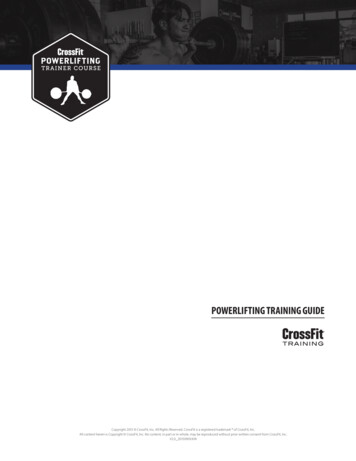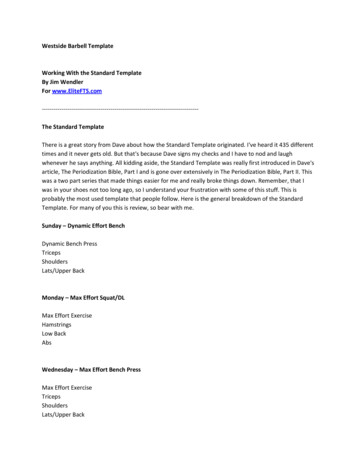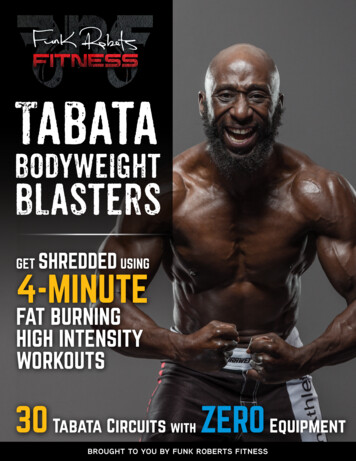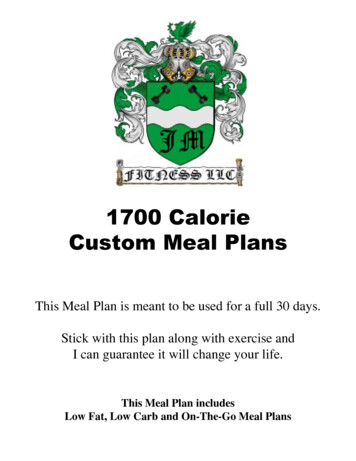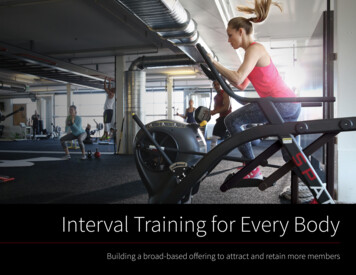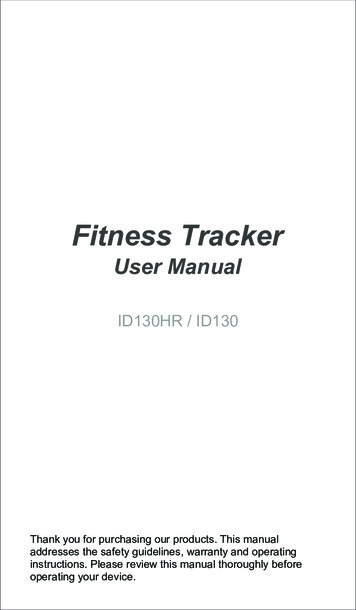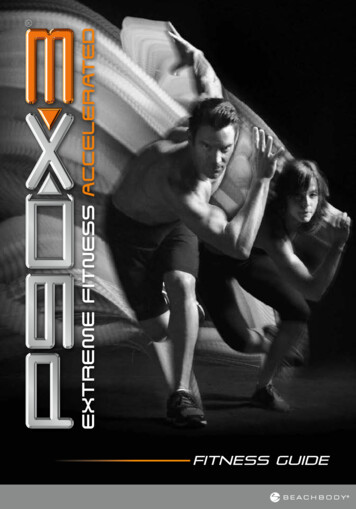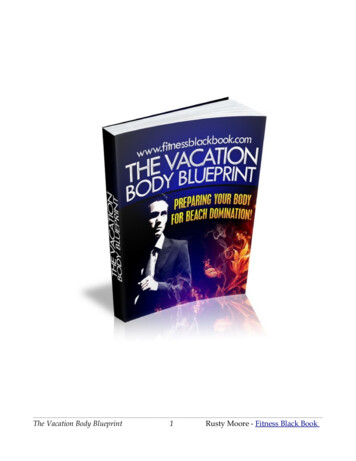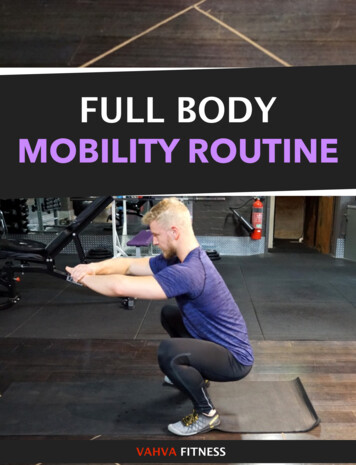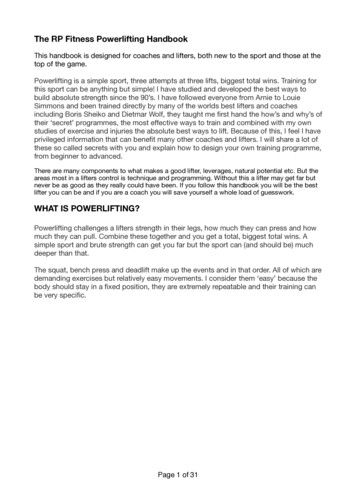
Transcription
The RP Fitness Powerlifting HandbookThis handbook is designed for coaches and lifters, both new to the sport and those at thetop of the game.Powerlifting is a simple sport, three attempts at three lifts, biggest total wins. Training forthis sport can be anything but simple! I have studied and developed the best ways tobuild absolute strength since the 90’s. I have followed everyone from Arnie to LouieSimmons and been trained directly by many of the worlds best lifters and coachesincluding Boris Sheiko and Dietmar Wolf, they taught me first hand the how’s and why’s oftheir ‘secret’ programmes, the most effective ways to train and combined with my ownstudies of exercise and injuries the absolute best ways to lift. Because of this, I feel I haveprivileged information that can benefit many other coaches and lifters. I will share a lot ofthese so called secrets with you and explain how to design your own training programme,from beginner to advanced.There are many components to what makes a good lifter, leverages, natural potential etc. But theareas most in a lifters control is technique and programming. Without this a lifter may get far butnever be as good as they really could have been. If you follow this handbook you will be the bestlifter you can be and if you are a coach you will save yourself a whole load of guesswork.WHAT IS POWERLIFTING?Powerlifting challenges a lifters strength in their legs, how much they can press and howmuch they can pull. Combine these together and you get a total, biggest total wins. Asimple sport and brute strength can get you far but the sport can (and should be) muchdeeper than that.The squat, bench press and deadlift make up the events and in that order. All of which aredemanding exercises but relatively easy movements. I consider them ‘easy’ because thebody should stay in a fixed position, they are extremely repeatable and their training canbe very specific.Page 1 of 31
THE RULESThere are many rules to the sport that a coach and lifter should become familiar with butmost importantly are the requirements and standards for a lift to pass in competition.These are the reasons to fail a lift according to current IPF rules:The Reasons To Fail A Squat Not hitting depth, depth is the top surface of the legs at the hip joint must be lower thanthe top of the knees). Failure to assume an upright position with the knees locked at the commencement andat the completion of the lift (because of this, a very low bar position can be problematicin standing fully upright). Stepping backwards or forward After the ‘squat’ command or before the ‘rack’command (do not accelerate into the end of a lift to avoid this). Failure to follow commands from the referee. Any downward movement during the ascent (including a double bounce at the bottomof the lift). Contact with bar or lifter by the spotters/loaders between the Chief referees signals, inorder to make the lift easier (this will be the referees opinion not the lifters). Contact of elbows or upper arms with the legs (this will be referees discretion). Any dropping or dumping of the bar during or after completion of the lift.The Reasons To Fail A Benchpress Bar is not lowered to chest or abdominal area (which is now allowed) This rule mostlyeffects equipped lifters who need to pull the bar down against the shirt). The bar cannot touch your belt if you wear one. (Unless it is to hold down a bench shirt Iadvise against it). Any downward movement of the whole of the bar in the course of being pressed out(this means either end of the bar can move downwards but not the centre of the bar andcan be difficult to ref so try to avoid this). Heaving, or sinking the bar after it has been motionless on the chest or abdominal area,in such a way as to aid the lifter. Failure to press the bar to straight arms length elbows locked at the completion of thelift (locking out unevenly is acceptable). Failure to observe the Chief Referees signals at the commencement, during orcompletion of the lift (for example, pressing or racking early). Any change in the elected lifting position during the lift proper, i.e. any raising movementof the head, shoulders or buttocks from their original points of contact with the bench,or lateral movement of the hands on the bar. the whole foot needs to be in contact withthe floor throughout the lift but a sideways slide can be acceptable (but not advisable). Contact with the bar or the lifter by the spotters/ loaders between the Chief Refereessignals, in order to make the lift easier. Any contact of the lifters feet with the bench or its supports. Deliberate contact between the bar and the bar rest supports during the lift in order tomake the lift easier. Failure to comply with any of the requirements contained in the general description ofthe lift, which precedes this list of disqualification.Page 2 of 31
The Reasons To Fail A Deadlift Failure to lock the knees straight at the completion of the lift. Failure to stand erect with the shoulders back. Any downward movement of the bar before it reaches the final position. If the barsettles as the shoulders come back this should not be reason to disqualify the lift. Supporting the bar on the thighs during the performance of the lift. If the bar edges upthe thighs but is not supported, this is not reason for disqualification (the referee canonly guess so don’t give them any doubt). Lowering the bar before receiving the Chief Referees signal. Allowing the bar to return to the platform without maintaining control with both hands,i.e. releasing the bar from the palms of the hand. Stepping backward or forward or moving the feet laterally. Rocking the feet between theball and heel is permitted. Foot movement after the command “Down” will not be causefor failure. So standing up too explosively is a common lifting error and can lead to thismistake. Failure to comply with any of the requirements contained in the general description ofthe lift, which precedes this list of disqualification.Lifting to the letter of the law and lifting in the spirit of the rules is not the same and Iconsider the above an absolute minimum and require a lot more out of a lifter for me toconsider the lifts good enough. In a competition whoever lifts the most wins but may wellnot be the best lifter.I think of this as a coffee shop trying to maximise profits. It couldA: Focus on excellent customer service and quality products.B: Use cheaper ingredients for a better mark up.Either could make money so by only looking at the bottom line you do not really see which is thebest shop.Getting back to lifting, this does not have to be a choice or compromise. Perfect form byit’s definition is the strongest way to complete a lift safely. This is often overlooked assometimes a lifter is stronger than their technique and the ego gets trained more than thelift. This way of lifting creates slow progress and a greater chance of injury. If a lifting errorhappens due to a weight increase then it is not a weak spot or a muscle group lacking. Itis simply too heavy and that exercise stops as soon as the form changes for the worse.Page 3 of 31
PERFECT FORMThis can be subjective and vary amongst lifters based on leverages, injuries, mobility andgeneral preferences. Many teaching cues are exaggerations of what is needed or simplythe opposite of a common error. Some lifting errors come from a misunderstanding ofwhen to apply a certain technique (ie. If equipped or raw). However there are manyconstants that should be strived for.The SquatThere is no short cut with squats, good bench pressers and dead lifters can beborn that way but squats take lots of hard work and lots of squats.Bar positionA lower bar position can be an asset but ONLY if the lifter does not have to alter theirtorso angle. As soon as a lifter leans over further the advantage of the bar being lower islost (besides, the rules state a lifter must be fully upright at the start and finish of thesquat).BracingBracing is done by keeping the torso completely fixed from when the bar is picked up towhen it finally gets re-racked and a classic case of less is more. The abs do not need tobrace particularly hard (around 30% of maximum). Their main action is spinal flexion andthat is not needed (or wanted in a squat). The glutes cannot contract maximally either asthey will need to allow the hips to flex to initiate the squat. Instead, these muscles shouldbuzz in the background allowing the movement to happen whilst actively stabilising thespine and hips. Do not stick the chest up or overarch, the feeling of tightness must notoutrank a neutral spine and head position.BreathingThis should be done by breathing in to the sides, it allows better oxygenation and stops alifter breathing into their chest (which elevates the shoulders lifting the bar higher) andstops a lifter breathing into their belly (which distends the abs and can cause excessivelumber extension). The breath itself should be no more than 80% of maximum air intake.Foot positionFeet should be as wide as flexibility and femur length allows. The feet should not bespaced wider than the knees can travel otherwise they will cave inwards. Weight shouldbe distributed equally between the heel and toes with a natural arch of the foot preserved(this is why lifting in shoes is preferable to barefoot). Feet should typically be turned outso as to track in the same direction as the knees.If the heels lift during the lift then you can train around this with lifting shoes that have aheel or putting weight plates under the heel. However that will not solve the issue, insteadwork on mobility and consider placing a weight plate under your toes on one or both feetduring your squats.The descentIf unequipped (raw) the lifter should squat downwards bending the knee and hipsimultaneously and equally. The knees will travel forward (not outward) relative to thePage 4 of 31
angle they are pointing in. Squatting ‘backwards’ works best for equipped lifters as theywill stretch the lifting suit this way.The bottom of the squatDepth is when the top of the thigh at the crease of the hip is LOWER than the knee. Makesure this is visible but not excessive. If this range of motion is not possible without thelower back going into flexion (buttwink) then you should refrain from squatting that low (atleast until the spine can be held in position throughout the exercise). Some people debateon whether this spinal flexion under load is bad or not but these are usually from peoplewho do not want to admit they have a problem that needs addressing.The ascentOn the way up focus on pushing against the bar, not the floor. If your hips pop up quickerthan the bar then your legs are weak (it is not your core or back). Do not accelerate the liftto completion, you will reduce training effect and risk unbalancing yourself or the bar afterwhat would have been a successful lift.Page 5 of 31
The Bench pressPossibly the most technically demanding of all the lifts. The bench press can benefit froma range of assistance exercises, much more so than the other two lifts but if I cannotstress enough to try to pause as many of your reps as you can to really excel in thismovement. Touch and go reps have their place but should never be used when trainingsingles.PositioningCreating an arch can put a lifter in a more shoulder friendly position, reduce the range ofmotion and take advantage of better leg drive.The arch is to get the chest as high as is possible so should come predominantly from theupper back. This means training your arch by putting a foam roller under your lower backwill not help much. Instead work on mobilising the upper back and shoulders.If the arch shrinks down during the lift do not correct it by putting bands around thebench to stop the slipping. This simply means your arch is does not have the enduranceto survive a set and will be the limiting factor until it develops (by practicing it more).Hand placementUnless injured EVERYONE should be trying to hold the bar as wide apart as is legal,which is the index finger covering the power rings (81cm apart). If this is wider than youare used to then progress the hands out each week around 1-2cm to get used to the newposition.The weight should rest on the bottom end of the palm so there is relatively little loadpulling the hand back. For this position wrist wraps are highly recommended as wrists donot recover quick enough between sessions to ever get used to it.Shoulder movementI have always found it a lazy (and inaccurate) teaching cue to say keep the shouldersback and down during the whole lift. Instead the shoulders should be allowed to glidetowards each other (but not squeeze together) as the bar is brought to a lifters chest andallowed to separate (but not be stretched forward) as the bar is pressed. This allows thearm to move more naturally around the collar bone and allow the elbow to lock outuninhibited.Bar pathThe bar path is both highly individual and the same for everyone. The elbow shouldremain directly under the bar thorough the lift and the bar brought down towards thestomach (once not allowed in competition but that rule no longer exists) and presseddirectly over the shoulders (not necessarily straight up). This creates more of an arc than astraight line seemingly increasing the distance the bar travels in. In reality the lifter is onlyworking to push the bar upwards so any horizontal bar movement creates little (if any)extra work.Leg driveThe feet (heels and toes) should remain flat on the ground throughout the lift. The legsmust be active to create stability and drive. If this causes the hips to lift then the lifter isprobably overextending the lumber and needs to get more arch from the thoracic spine.Page 6 of 31
For some lifters blocks are necessary and in training a lifter may want to rest their back inwhich case a flat back and feet up position is perfectly acceptable.To spot or notThe bench press need
The RP Fitness Powerlifting Handbook This handbook is designed for coaches and lifters, both new to the sport and those at the top of the game. Powerlifting is a simple sport, three attempts at three lifts, biggest total wins. Training for this sport can be anything but simple!
